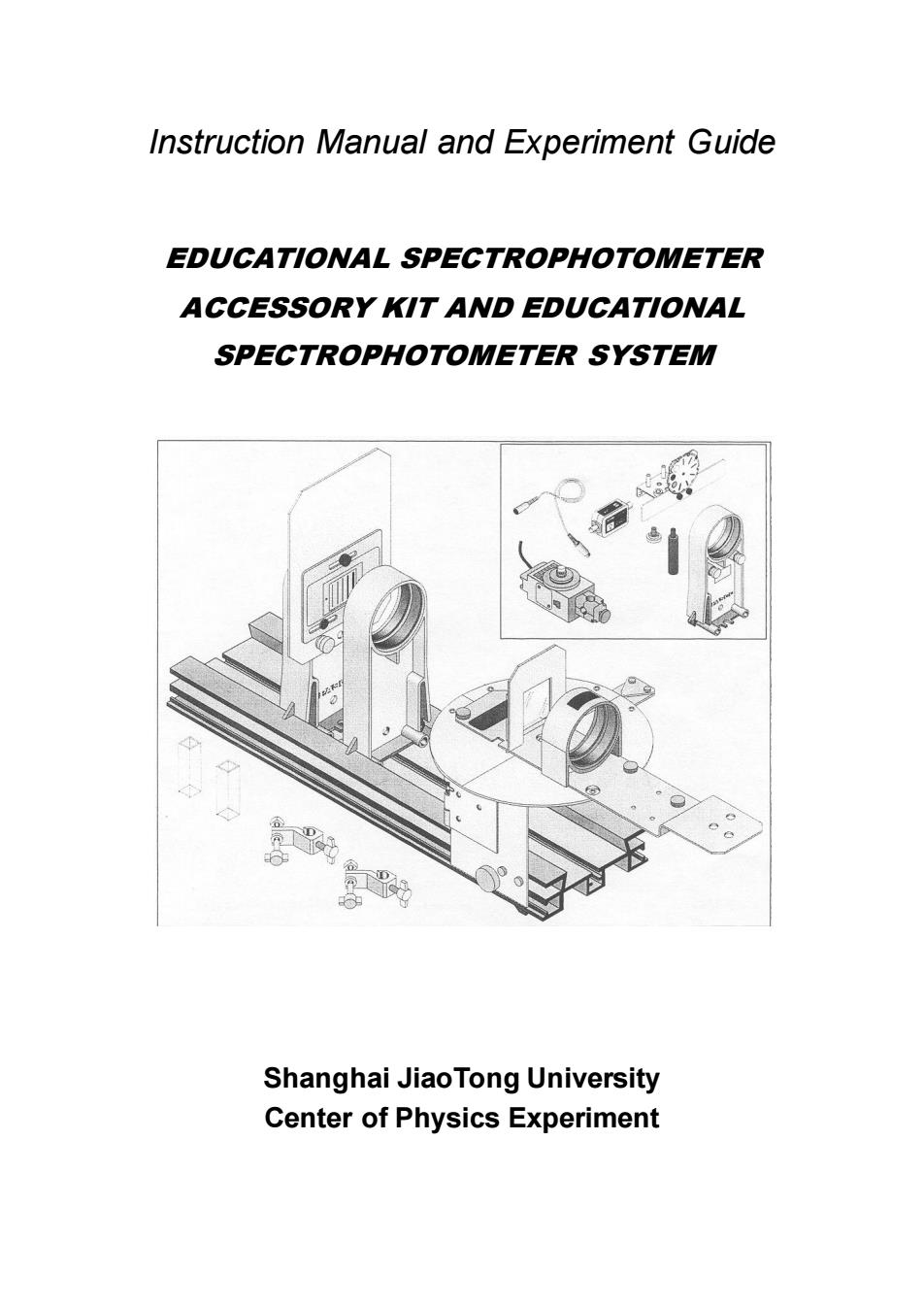
Instruction Manual and Experiment Guide EDUCATIONAL SPECTROPHOTOMETER ACCESSORY KIT AND EDUCATIONAL SPECTROPHOTOMETER SYSTEM Shanghai JiaoTong University Center of Physics Experiment
Instruction Manual and Experiment Guide EDUCATIONAL SPECTROPHOTOMETER ACCESSORY KIT AND EDUCATIONAL SPECTROPHOTOMETER SYSTEM Shanghai JiaoTong University Center of Physics Experiment
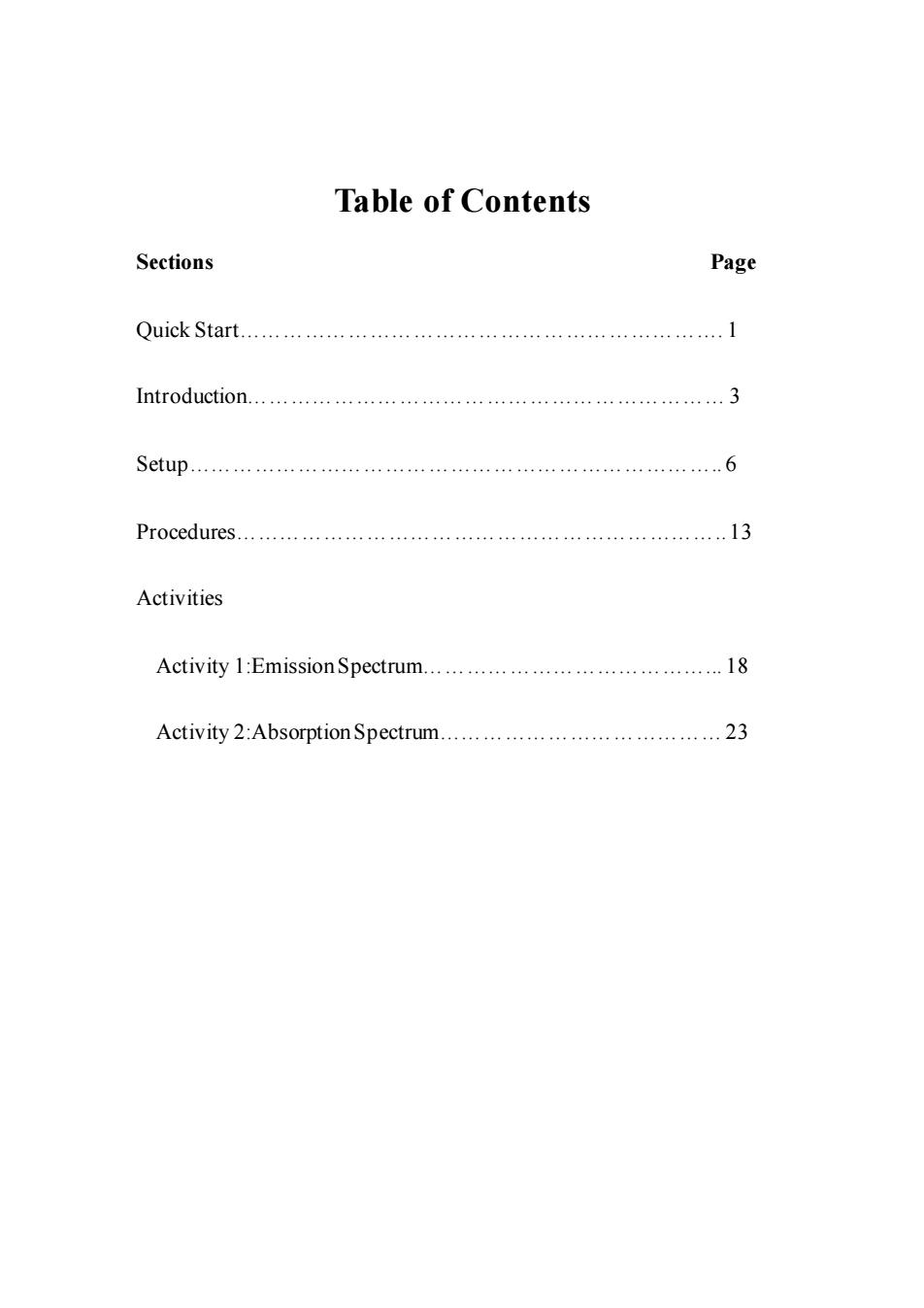
Table of Contents Sections Page Quick Start..…… Introduction.... 52 Setup.……… …6 Procedures.….… 13 Activities Activity 1:EmissionSpectrum.......18 Activity 2:Absorption Spectrum....................................... 3
Table of Contents Sections Page Quick Start…………………………………………………………. 1 Introduction…………………………………………………………3 Setup……………………………………………………………….. 6 Procedures…………………………………………………………..13 Activities Activity 1:Emission Spectrum…………………………………... 18 Activity 2:Absorption Spectrum…………………………………23
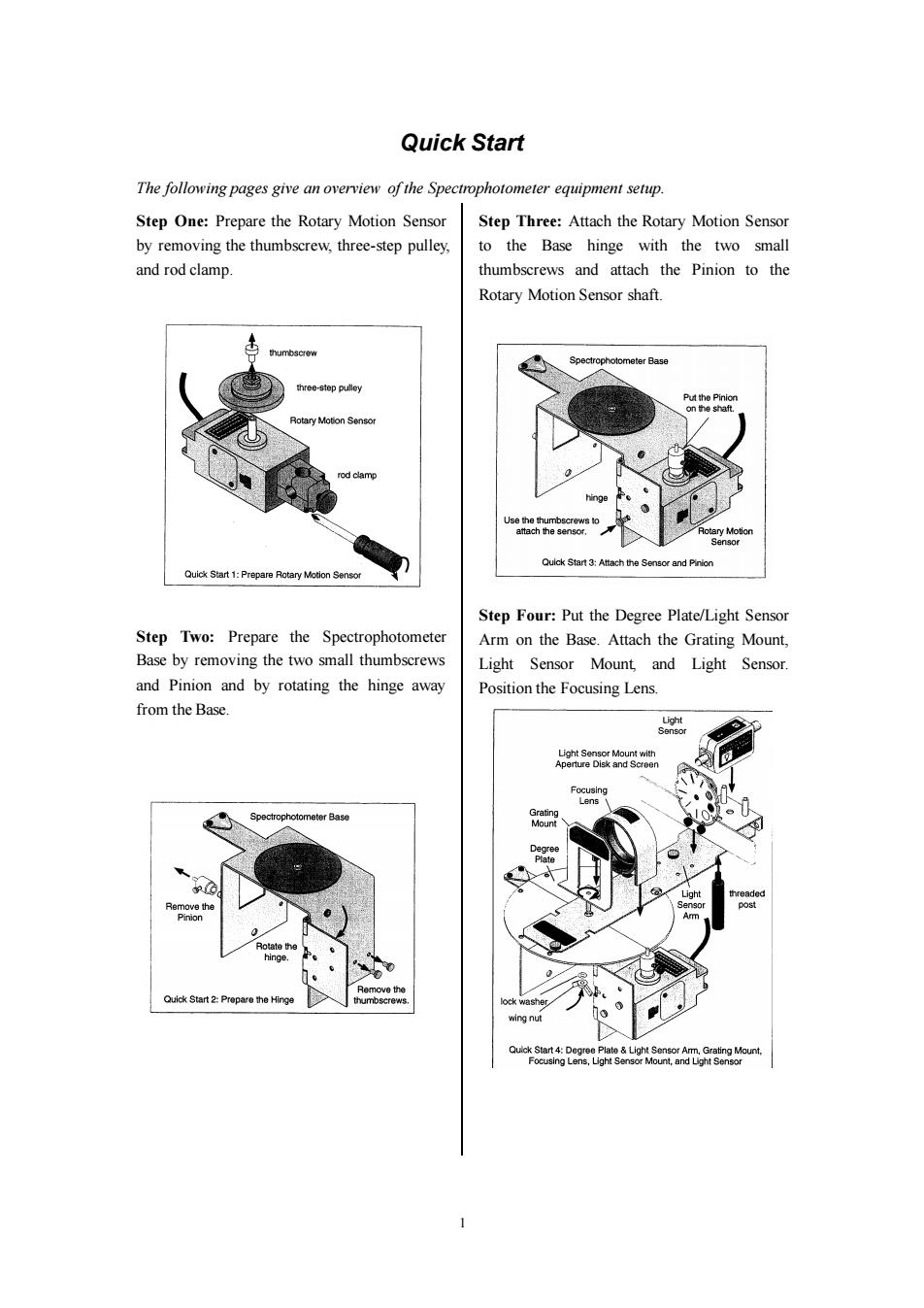
Quick Start The following pages give an overview of the Spectrophotometer equipment setup. Step One:Prepare the Rotary Motion Sensor Step Three:Attach the Rotary Motion Sensor by removing the thumbscrew,three-step pulley, to the Base hinge with the two small and rod clamp. thumbscrews and attach the Pinion to the Rotary Motion Sensor shaft. thumbscrew Spectrophotometer Base three-step pulley Put the Pinion on行e shaft. Rotary Motion Sensor rod clamp attach Quick Start 3:Attach the Sensor and Pinion Quick Start 1:Prepare Rotary Motion Sensor Step Four:Put the Degree Plate/Light Sensor Step Two:Prepare the Spectrophotometer Arm on the Base.Attach the Grating Mount. Base by removing the two small thumbscrews Light Sensor Mount and Light Sensor. and Pinion and by rotating the hinge away Position the Focusing Lens from the Base. Light Sensor Light Sensor Mount with Aperture Disk and Scroen Focusing Lens Spectrophotometer Base Grating Mount Light Remove the Senso post Pinion 0. e the Quick Start 2:Prepare the Hinge mbs wing nu Qulck Start 4:D Plate Light Se Grating Mount, Focusing Lens,Light S nt,and Lignt Sensor
1 Quick Start The following pages give an overview of the Spectrophotometer equipment setup. Step One: Prepare the Rotary Motion Sensor by removing the thumbscrew, three-step pulley, and rod clamp. Step Two: Prepare the Spectrophotometer Base by removing the two small thumbscrews and Pinion and by rotating the hinge away from the Base. Step Three: Attach the Rotary Motion Sensor to the Base hinge with the two small thumbscrews and attach the Pinion to the Rotary Motion Sensor shaft. Step Four: Put the Degree Plate/Light Sensor Arm on the Base. Attach the Grating Mount, Light Sensor Mount, and Light Sensor. Position the Focusing Lens
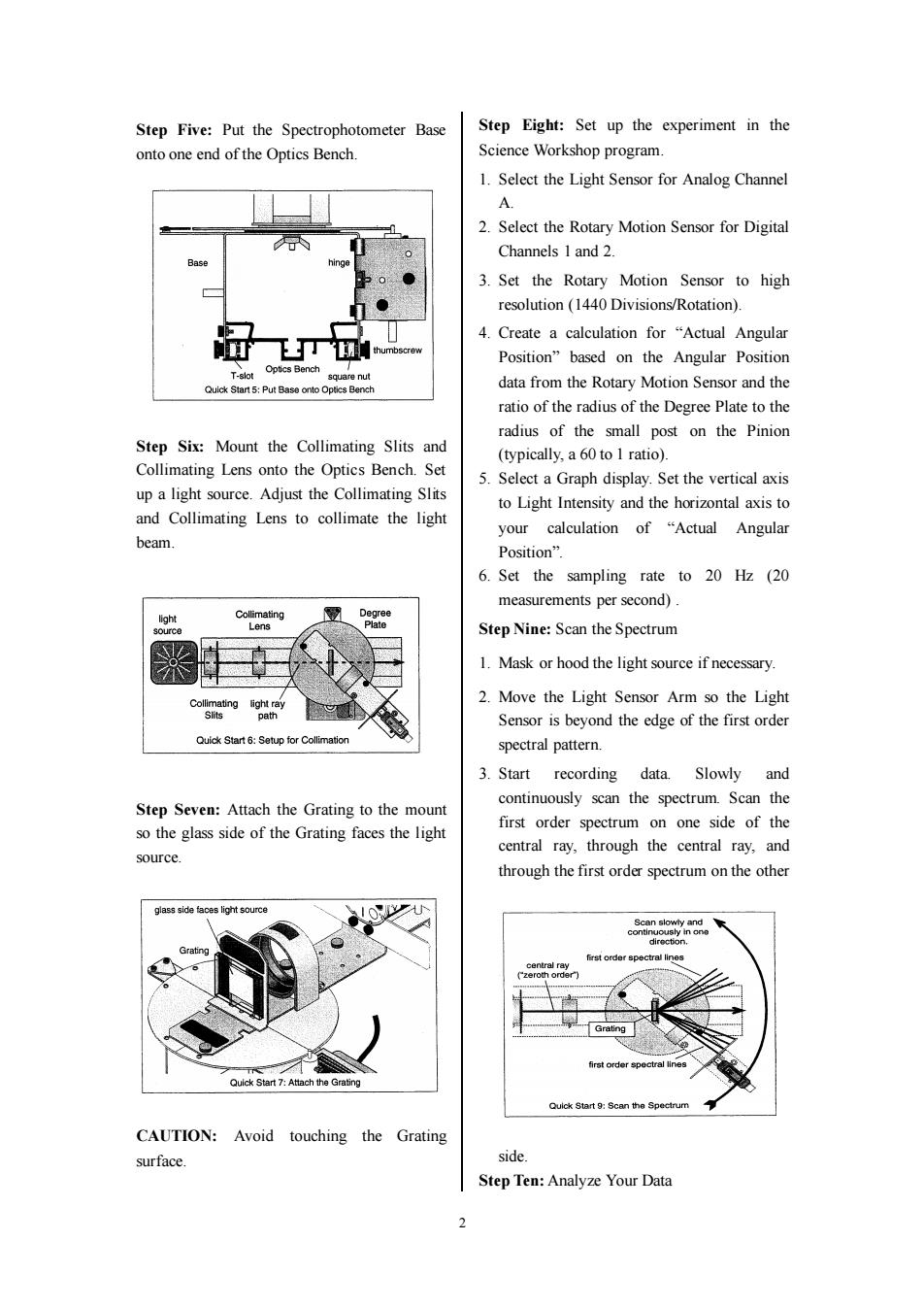
Step Five:Put the Spectrophotometer Base Step Eight:Set up the experiment in the onto one end of the Optics Bench Science Workshop program. 1.Select the Light Sensor for Analog Channel 2.Select the Rotary Motion Sensor for Digital Channels 1 and 2. Base hinge 3.Set the Rotary Motion Sensor to high resolution (1440 Divisions/Rotation). 4.Create a calculation for "Actual Angular Position"based on the Angular Position T-slot Optics Bench square nut Quick Start 5:Put Base onto Optics Bench data from the Rotary Motion Sensor and the ratio of the radius of the Degree Plate to the radius of the small post on the Pinion Step Six:Mount the Collimating Slits and (typically,a 60 to 1 ratio). Collimating Lens onto the Optics Bench.Set 5.Select a Graph display.Set the vertical axis up a light source.Adjust the Collimating Slits to Light Intensity and the horizontal axis to and Collimating Lens to collimate the light your calculation of "Actual Angular beam. Position” 6.Set the sampling rate to 20 Hz (20 measurements per second). light Collimating source Lens Step Nine:Scan the Spectrum 1.Mask or hood the light source if necessary. Collimating light ray 2.Move the Light Sensor Arm so the Light Slits path Sensor is beyond the edge of the first order Quick Start 6:Setup for Collimation spectral pattern. 3.Start recording data.Slowly and continuously scan the spectrum.Scan the Step Seven:Attach the Grating to the mount so the glass side of the Grating faces the light first order spectrum on one side of the central ray,through the central ray,and source. through the first order spectrum on the other glass side faces light source Scan slowly and continuously in one direction. central ray first order spectral lines (zeroth order) first order spectral lines Quick ch the Grating Quick Start 9:Scan the Spectrum CAUTION:Avoid touching the Grating surface. side Step Ten:Analyze Your Data 2
2 Step Five: Put the Spectrophotometer Base onto one end of the Optics Bench. Step Six: Mount the Collimating Slits and Collimating Lens onto the Optics Bench. Set up a light source. Adjust the Collimating Slits and Collimating Lens to collimate the light beam. Step Seven: Attach the Grating to the mount so the glass side of the Grating faces the light source. CAUTION: Avoid touching the Grating surface. Step Eight: Set up the experiment in the Science Workshop program. 1. Select the Light Sensor for Analog Channel A. 2. Select the Rotary Motion Sensor for Digital Channels 1 and 2. 3. Set the Rotary Motion Sensor to high resolution (1440 Divisions/Rotation). 4. Create a calculation for “Actual Angular Position” based on the Angular Position data from the Rotary Motion Sensor and the ratio of the radius of the Degree Plate to the radius of the small post on the Pinion (typically, a 60 to 1 ratio). 5. Select a Graph display. Set the vertical axis to Light Intensity and the horizontal axis to your calculation of “Actual Angular Position”. 6. Set the sampling rate to 20 Hz (20 measurements per second) . Step Nine: Scan the Spectrum 1. Mask or hood the light source if necessary. 2. Move the Light Sensor Arm so the Light Sensor is beyond the edge of the first order spectral pattern. 3. Start recording data. Slowly and continuously scan the spectrum. Scan the first order spectrum on one side of the central ray, through the central ray, and through the first order spectrum on the other side. Step Ten: Analyze Your Data
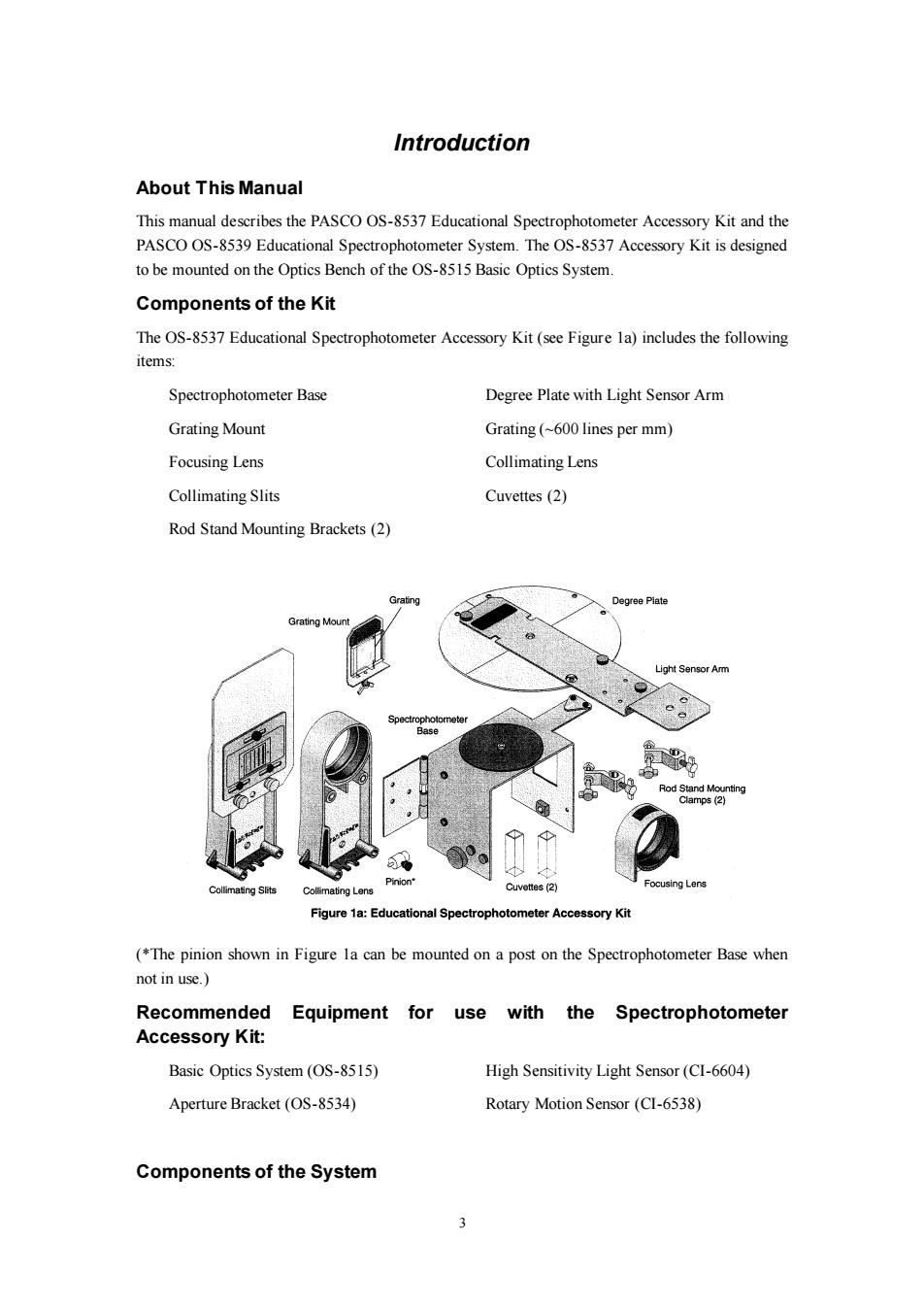
Introduction About This Manual This manual describes the PASCO OS-8537 Educational Spectrophotometer Accessory Kit and the PASCO OS-8539 Educational Spectrophotometer System.The OS-8537 Accessory Kit is designed to be mounted on the Optics Bench of the OS-8515 Basic Optics System. Components of the Kit The OS-8537 Educational Spectrophotometer Accessory Kit(see Figure la)includes the following items: Spectrophotometer Base Degree Plate with Light Sensor Arm Grating Mount Grating(~600 lines per mm) Focusing Lens Collimating Lens Collimating Slits Cuvettes (2) Rod Stand Mounting Brackets(2) Grating Degree Plate Grating Mount Light Sensor Amm Spectrophotometer Base Rod Stand Mo nting Clamps (2) Pinion' Collimating Slits Cuvettes (2) Focusing Lens Figure 1a:Educational Spectrophotometer Accessory Kit (*The pinion shown in Figure la can be mounted on a post on the Spectrophotometer Base when not in use. Recommended Equipment for use with the Spectrophotometer Accessory Kit: Basic Optics System(OS-8515) High Sensitivity Light Sensor(CI-6604) Aperture Bracket(OS-8534) Rotary Motion Sensor(CI-6538) Components of the System 3
3 Introduction About This Manual This manual describes the PASCO OS-8537 Educational Spectrophotometer Accessory Kit and the PASCO OS-8539 Educational Spectrophotometer System. The OS-8537 Accessory Kit is designed to be mounted on the Optics Bench of the OS-8515 Basic Optics System. Components of the Kit The OS-8537 Educational Spectrophotometer Accessory Kit (see Figure 1a) includes the following items: Spectrophotometer Base Degree Plate with Light Sensor Arm Grating Mount Grating (~600 lines per mm) Focusing Lens Collimating Lens Collimating Slits Cuvettes (2) Rod Stand Mounting Brackets (2) (*The pinion shown in Figure 1a can be mounted on a post on the Spectrophotometer Base when not in use.) Recommended Equipment for use with the Spectrophotometer Accessory Kit: Basic Optics System (OS-8515) High Sensitivity Light Sensor (CI-6604) Aperture Bracket (OS-8534) Rotary Motion Sensor (CI-6538) Components of the System
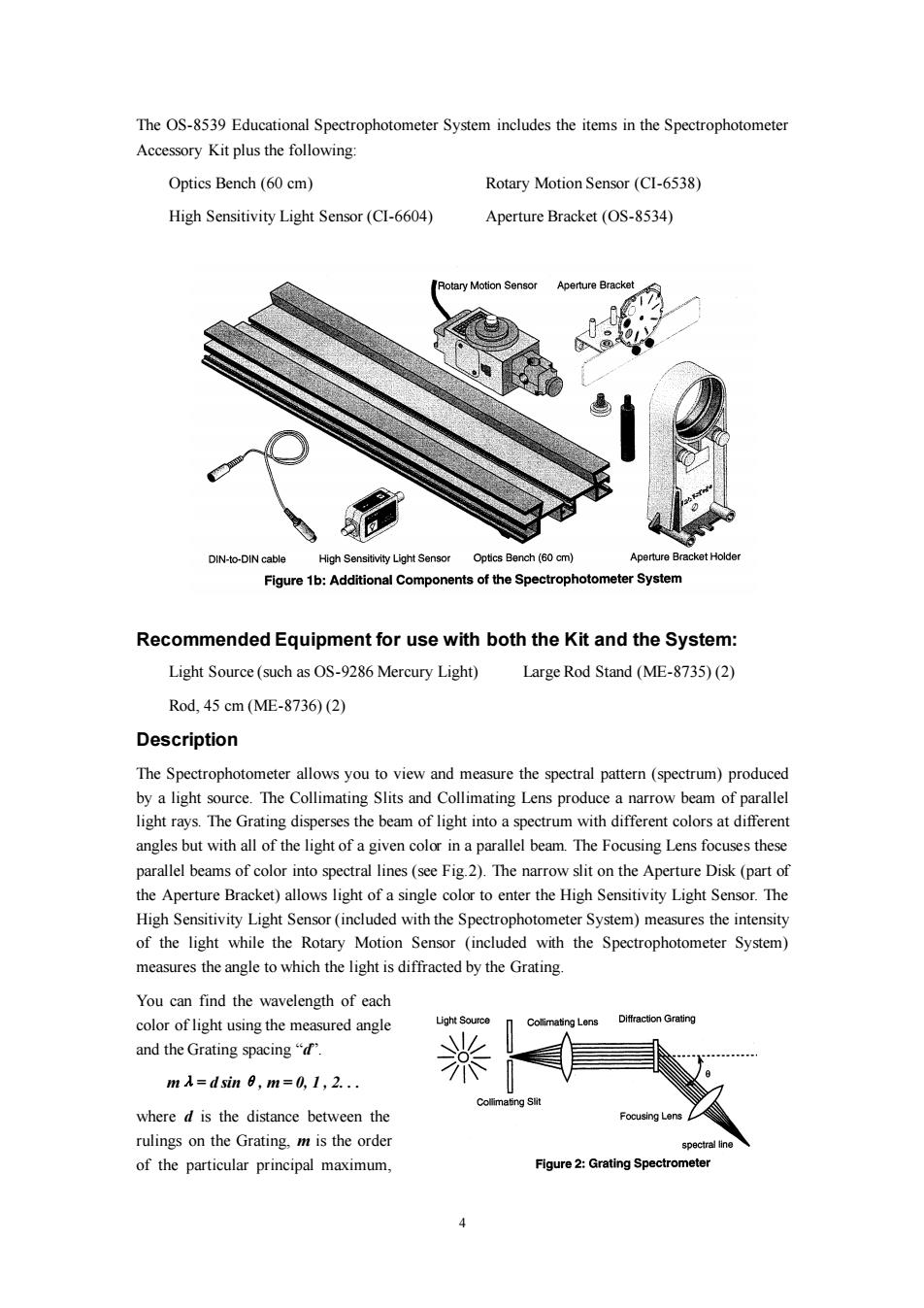
The OS-8539 Educational Spectrophotometer System includes the items in the Spectrophotometer Accessory Kit plus the following: Optics Bench (60 cm) Rotary Motion Sensor(CI-6538) High Sensitivity Light Sensor(CI-6604) Aperture Bracket(OS-8534) Rotary Motion Sensor Aperture Bracket DIN-to-DIN cable High Sensitivity Light Sensor Optics Bench (60 cm) Aperture Bracket Holder Figure 1b:Additional Components of the Spectrophotometer System Recommended Equipment for use with both the Kit and the System: Light Source(such as OS-9286 Mercury Light) Large Rod Stand(ME-8735)(2) Rod,45cm(ME-8736)(2) Description The Spectrophotometer allows you to view and measure the spectral pattern(spectrum)produced by a light source.The Collimating Slits and Collimating Lens produce a narrow beam of parallel light rays.The Grating disperses the beam of light into a spectrum with different colors at different angles but with all of the light of a given color in a parallel beam.The Focusing Lens focuses these parallel beams of color into spectral lines(see Fig.2).The narrow slit on the Aperture Disk(part of the Aperture Bracket)allows light of a single color to enter the High Sensitivity Light Sensor.The High Sensitivity Light Sensor(included with the Spectrophotometer System)measures the intensity of the light while the Rotary Motion Sensor (included with the Spectrophotometer System) measures the angle to which the light is diffracted by the Grating. You can find the wavelength of each color of light using the measured angle Light Source mating Lens Diffraction Grating and the Grating spacing"d. 米 mA=dsin8,m=0,1,2.. Collimating Slit where d is the distance between the Focusing Lens rulings on the Grating,m is the order spectral line of the particular principal maximum, Figure 2:Grating Spectrometer
4 The OS-8539 Educational Spectrophotometer System includes the items in the Spectrophotometer Accessory Kit plus the following: Optics Bench (60 cm) Rotary Motion Sensor (CI-6538) High Sensitivity Light Sensor (CI-6604) Aperture Bracket (OS-8534) Recommended Equipment for use with both the Kit and the System: Light Source (such as OS-9286 Mercury Light) Large Rod Stand (ME-8735) (2) Rod, 45 cm (ME-8736) (2) Description The Spectrophotometer allows you to view and measure the spectral pattern (spectrum) produced by a light source. The Collimating Slits and Collimating Lens produce a narrow beam of parallel light rays. The Grating disperses the beam of light into a spectrum with different colors at different angles but with all of the light of a given color in a parallel beam. The Focusing Lens focuses these parallel beams of color into spectral lines (see Fig.2). The narrow slit on the Aperture Disk (part of the Aperture Bracket) allows light of a single color to enter the High Sensitivity Light Sensor. The High Sensitivity Light Sensor (included with the Spectrophotometer System) measures the intensity of the light while the Rotary Motion Sensor (included with the Spectrophotometer System) measures the angle to which the light is diffracted by the Grating. You can find the wavelength of each color of light using the measured angle and the Grating spacing “d”. mλ= d sinθ, m = 0, 1 , 2. . . where d is the distance between the rulings on the Grating, m is the order of the particular principal maximum
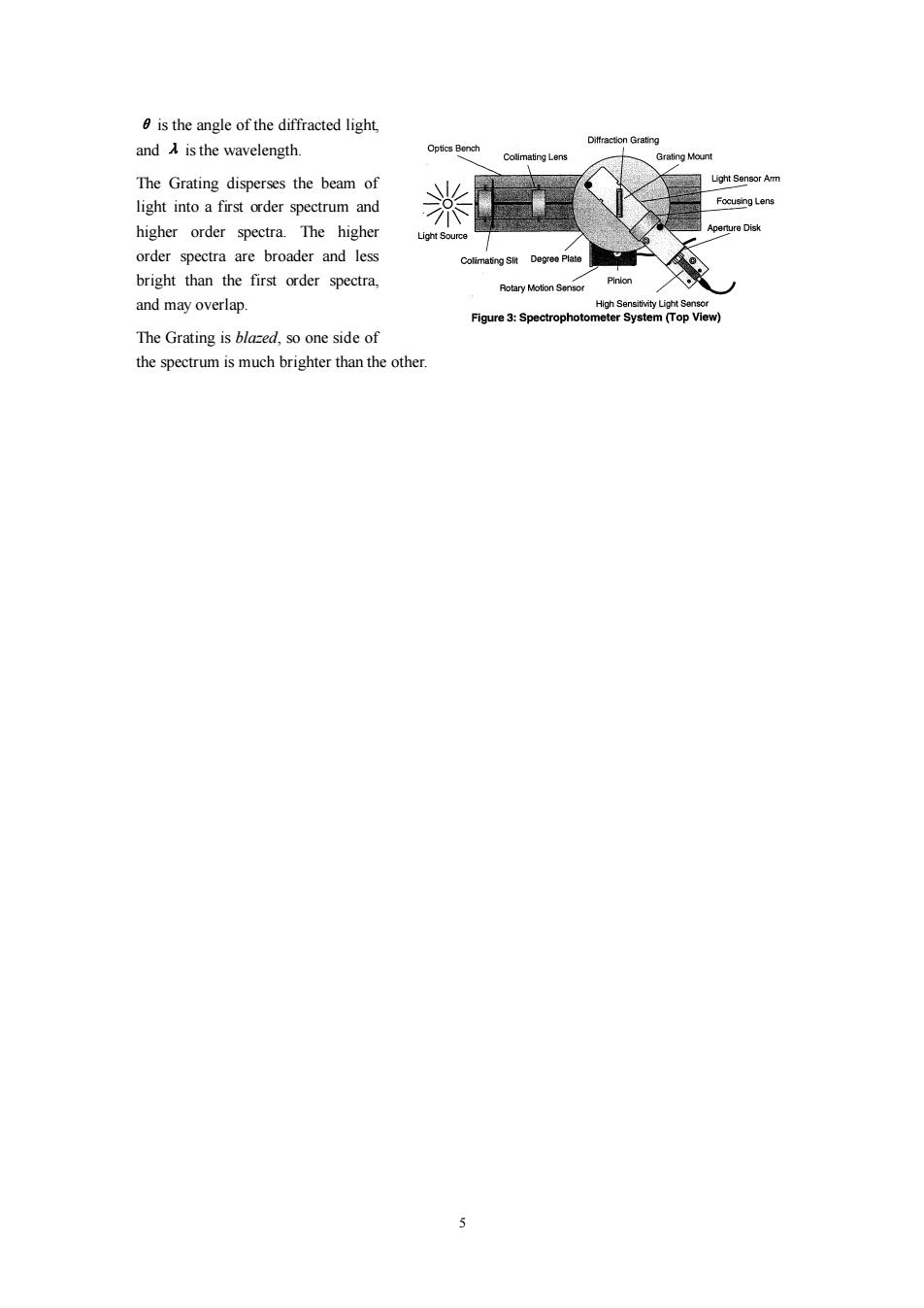
is the angle of the diffracted light, and is the wavelength Ditfraction Grating Optics Bench Collimating Lens Grating Mount The Grating disperses the beam of Light Sensor Amm light into a first order spectrum and 米 Focusing Lens higher order spectra.The higher Light Source Aperture Disk order spectra are broader and less Colimating Slit Degree Plate bright than the first order spectra, Pinion Rotary Motion Sensor and may overlap. High Sensitivity Light Sensor Figure 3:Spectrophotometer System (Top View) The Grating is blazed,so one side of the spectrum is much brighter than the other 5
5 θ is the angle of the diffracted light, and λ is the wavelength. The Grating disperses the beam of light into a first order spectrum and higher order spectra. The higher order spectra are broader and less bright than the first order spectra, and may overlap. The Grating is blazed, so one side of the spectrum is much brighter than the other
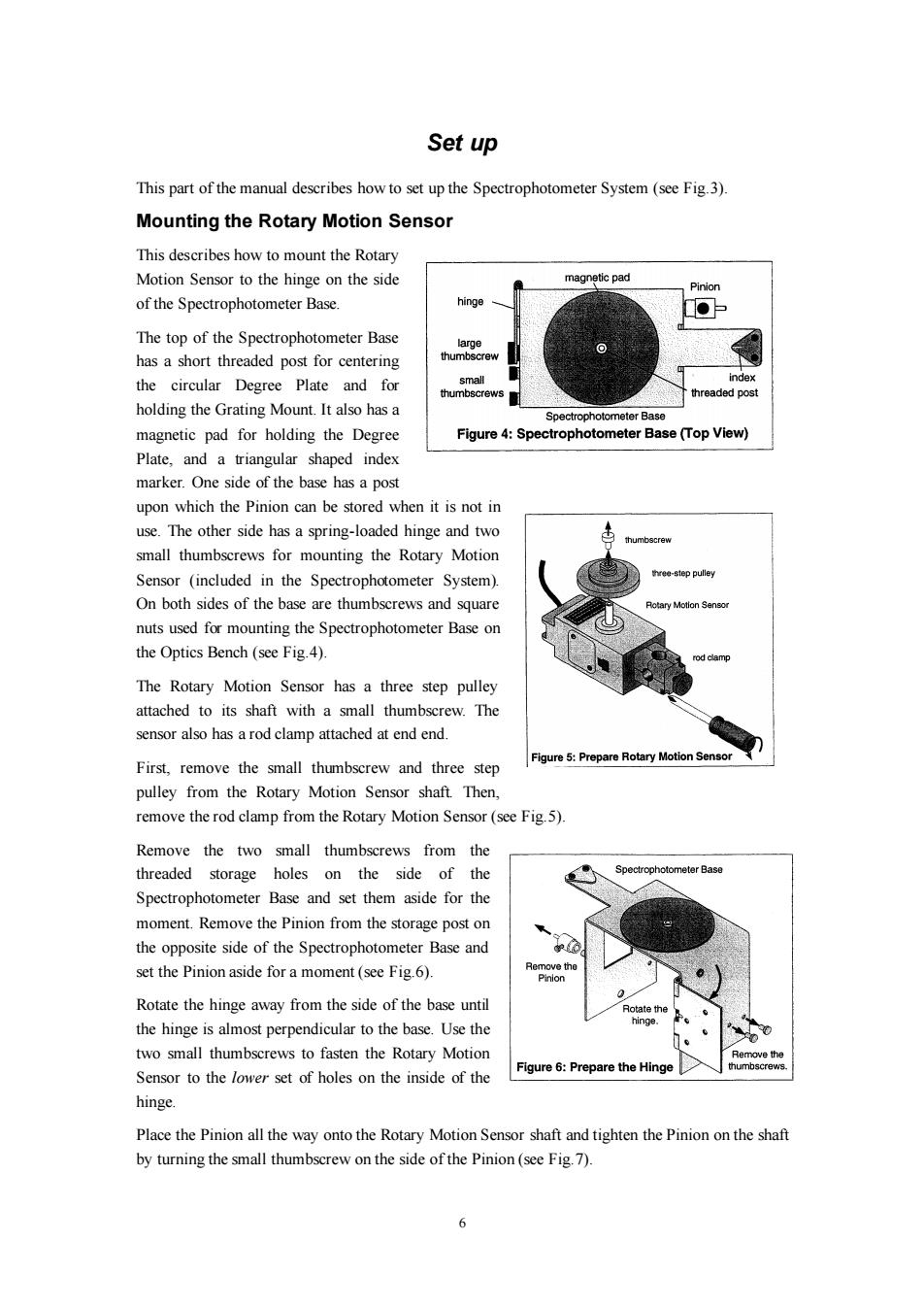
Set up This part of the manual describes how to set up the Spectrophotometer System (see Fig.3). Mounting the Rotary Motion Sensor This describes how to mount the Rotary Motion Sensor to the hinge on the side magnetic pad Pinion of the Spectrophotometer Base. hinge The top of the Spectrophotometer Base large has a short threaded post for centering thumbscrew the circular Degree Plate and for small index thumbscrews threaded post holding the Grating Mount.It also has a Spectrophotometer Base magnetic pad for holding the Degree Figure 4:Spectrophotometer Base (Top View) Plate,and a triangular shaped index marker.One side of the base has a post upon which the Pinion can be stored when it is not in use.The other side has a spring-loaded hinge and two thumbscrew small thumbscrews for mounting the Rotary Motion Sensor (included in the Spectrophotometer System). three-step pulley On both sides of the base are thumbscrews and square Rotary Motion Sensor nuts used for mounting the Spectrophotometer Base on the Optics Bench(see Fig.4). rod cle m The Rotary Motion Sensor has a three step pulley attached to its shaft with a small thumbscrew.The sensor also has a rod clamp attached at end end. Figure 5:Prepare Rotary Motion Sensor First,remove the small thumbscrew and three step pulley from the Rotary Motion Sensor shaft.Then remove the rod clamp from the Rotary Motion Sensor(see Fig.5). Remove the two small thumbscrews from the threaded storage holes on the side of the Spectrophotometer Base Spectrophotometer Base and set them aside for the moment.Remove the Pinion from the storage post on the opposite side of the Spectrophotometer Base and set the Pinion aside for a moment(see Fig.6). Remove the Pinion 0 Rotate the hinge away from the side of the base until Rotate the the hinge is almost perpendicular to the base.Use the hinge. two small thumbscrews to fasten the Rotary Motion Figure 6:Prepare the Hinge Sensor to the lower set of holes on the inside of the hinge Place the Pinion all the way onto the Rotary Motion Sensor shaft and tighten the Pinion on the shaft by turning the small thumbscrew on the side of the Pinion(see Fig.7). 6
6 Set up This part of the manual describes how to set up the Spectrophotometer System (see Fig.3). Mounting the Rotary Motion Sensor This describes how to mount the Rotary Motion Sensor to the hinge on the side of the Spectrophotometer Base. The top of the Spectrophotometer Base has a short threaded post for centering the circular Degree Plate and for holding the Grating Mount. It also has a magnetic pad for holding the Degree Plate, and a triangular shaped index marker. One side of the base has a post upon which the Pinion can be stored when it is not in use. The other side has a spring-loaded hinge and two small thumbscrews for mounting the Rotary Motion Sensor (included in the Spectrophotometer System). On both sides of the base are thumbscrews and square nuts used for mounting the Spectrophotometer Base on the Optics Bench (see Fig.4). The Rotary Motion Sensor has a three step pulley attached to its shaft with a small thumbscrew. The sensor also has a rod clamp attached at end end. First, remove the small thumbscrew and three step pulley from the Rotary Motion Sensor shaft. Then, remove the rod clamp from the Rotary Motion Sensor (see Fig.5). Remove the two small thumbscrews from the threaded storage holes on the side of the Spectrophotometer Base and set them aside for the moment. Remove the Pinion from the storage post on the opposite side of the Spectrophotometer Base and set the Pinion aside for a moment (see Fig.6). Rotate the hinge away from the side of the base until the hinge is almost perpendicular to the base. Use the two small thumbscrews to fasten the Rotary Motion Sensor to the lower set of holes on the inside of the hinge. Place the Pinion all the way onto the Rotary Motion Sensor shaft and tighten the Pinion on the shaft by turning the small thumbscrew on the side of the Pinion (see Fig.7)
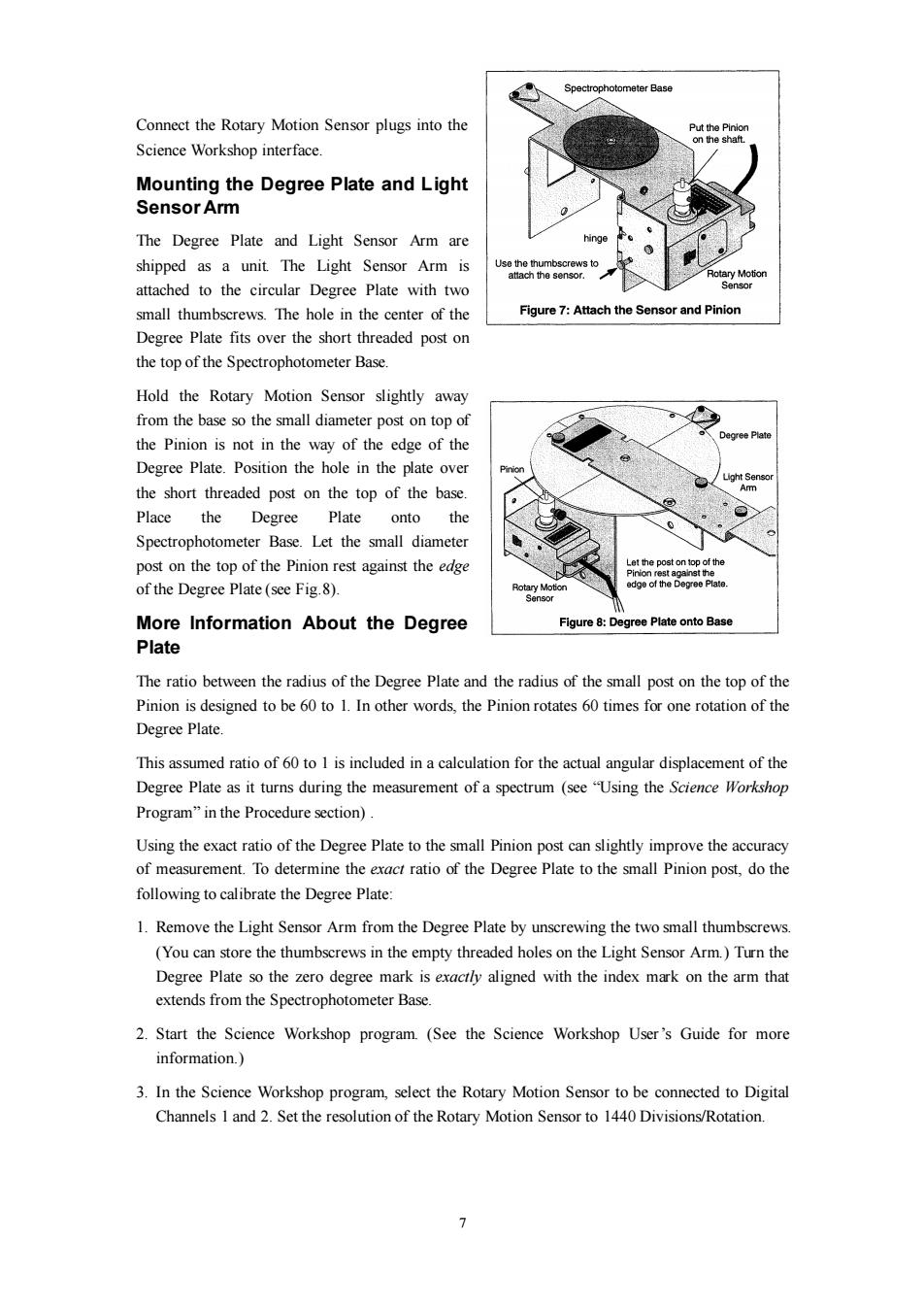
Spectrophotometer Base Connect the Rotary Motion Sensor plugs into the Put the Pinion Science Workshop interface. on the shaft. Mounting the Degree Plate and Light Sensor Arm The Degree Plate and Light Sensor Arm are shipped as a unit.The Light Sensor Arm is Use the thumbscrew attach the senso Rotary Motion attached to the circular Degree Plate with two Sensor small thumbscrews.The hole in the center of the Figure 7:Attach the Sensor and Pinion Degree Plate fits over the short threaded post on the top of the Spectrophotometer Base. Hold the Rotary Motion Sensor slightly away from the base so the small diameter post on top of the Pinion is not in the way of the edge of the Degree Plate Degree Plate.Position the hole in the plate over the short threaded post on the top of the base. m Place the Degree Plate onto the Spectrophotometer Base.Let the small diameter post on the top of the Pinion rest against the edge Let the post on top of the Pinion rest against the of the Degree Plate (see Fig.8). edge of the Degree Plate. More Information About the Degree Figure 8:Degree Plate onto Base Plate The ratio between the radius of the Degree Plate and the radius of the small post on the top of the Pinion is designed to be 60 to 1.In other words,the Pinion rotates 60 times for one rotation of the Degree Plate. This assumed ratio of 60 to 1 is included in a calculation for the actual angular displacement of the Degree Plate as it turns during the measurement of a spectrum (see"Using the Science Workshop Program"in the Procedure section). Using the exact ratio of the Degree Plate to the small Pinion post can slightly improve the accuracy of measurement.To determine the exact ratio of the Degree Plate to the small Pinion post,do the following to calibrate the Degree Plate: 1.Remove the Light Sensor Arm from the Degree Plate by unscrewing the two small thumbscrews. (You can store the thumbscrews in the empty threaded holes on the Light Sensor Arm.)Turn the Degree Plate so the zero degree mark is exactly aligned with the index mark on the arm that extends from the Spectrophotometer Base. 2.Start the Science Workshop program.(See the Science Workshop User's Guide for more information.) 3.In the Science Workshop program,select the Rotary Motion Sensor to be connected to Digital Channels 1 and 2.Set the resolution of the Rotary Motion Sensor to 1440 Divisions/Rotation. >
7 Connect the Rotary Motion Sensor plugs into the Science Workshop interface. Mounting the Degree Plate and Light Sensor Arm The Degree Plate and Light Sensor Arm are shipped as a unit. The Light Sensor Arm is attached to the circular Degree Plate with two small thumbscrews. The hole in the center of the Degree Plate fits over the short threaded post on the top of the Spectrophotometer Base. Hold the Rotary Motion Sensor slightly away from the base so the small diameter post on top of the Pinion is not in the way of the edge of the Degree Plate. Position the hole in the plate over the short threaded post on the top of the base. Place the Degree Plate onto the Spectrophotometer Base. Let the small diameter post on the top of the Pinion rest against the edge of the Degree Plate (see Fig.8). More Information About the Degree Plate The ratio between the radius of the Degree Plate and the radius of the small post on the top of the Pinion is designed to be 60 to 1. In other words, the Pinion rotates 60 times for one rotation of the Degree Plate. This assumed ratio of 60 to 1 is included in a calculation for the actual angular displacement of the Degree Plate as it turns during the measurement of a spectrum (see “Using the Science Workshop Program” in the Procedure section) . Using the exact ratio of the Degree Plate to the small Pinion post can slightly improve the accuracy of measurement. To determine the exact ratio of the Degree Plate to the small Pinion post, do the following to calibrate the Degree Plate: 1. Remove the Light Sensor Arm from the Degree Plate by unscrewing the two small thumbscrews. (You can store the thumbscrews in the empty threaded holes on the Light Sensor Arm.) Turn the Degree Plate so the zero degree mark is exactly aligned with the index mark on the arm that extends from the Spectrophotometer Base. 2. Start the Science Workshop program. (See the Science Workshop User’s Guide for more information.) 3. In the Science Workshop program, select the Rotary Motion Sensor to be connected to Digital Channels 1 and 2. Set the resolution of the Rotary Motion Sensor to 1440 Divisions/Rotation
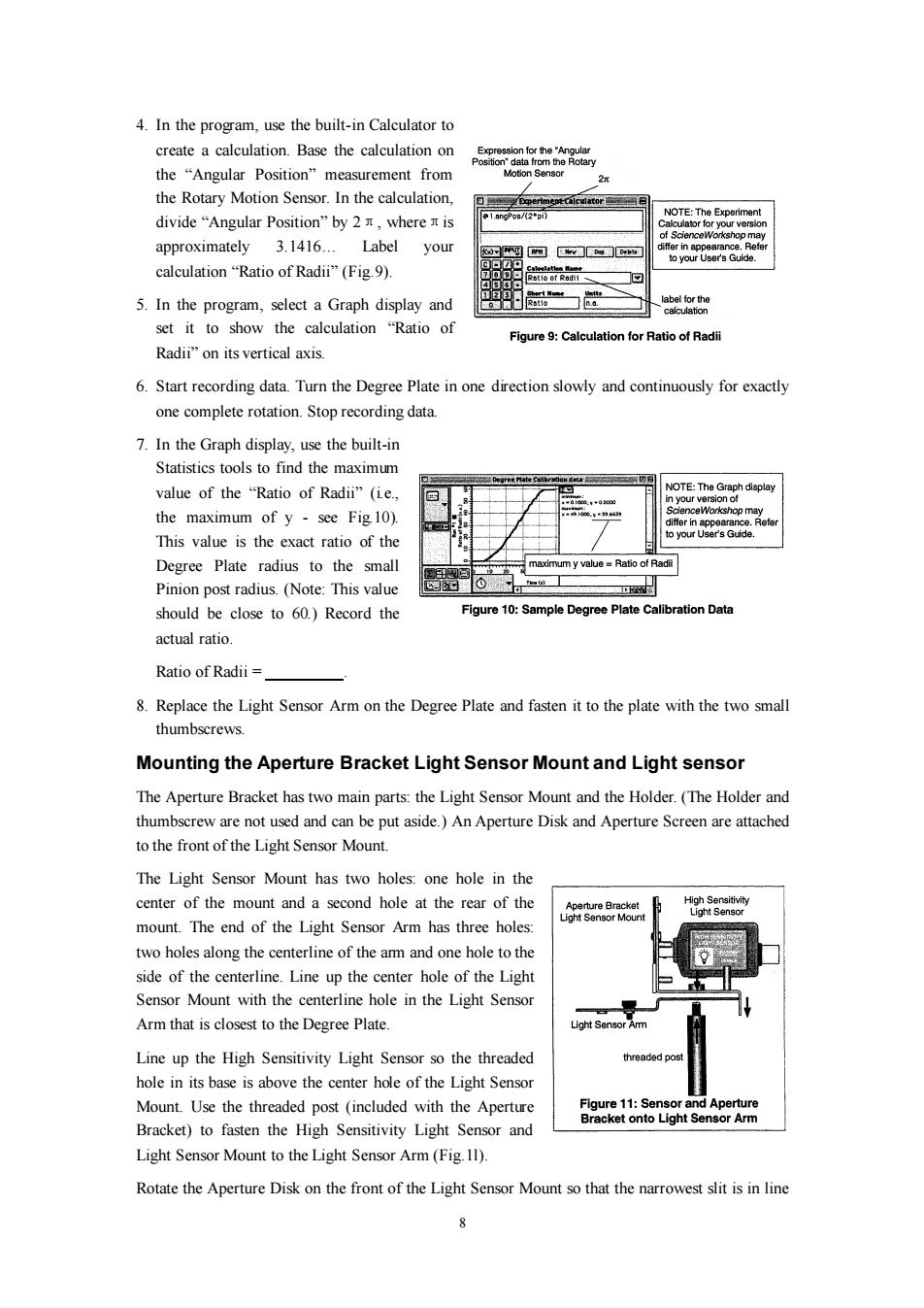
4.In the program,use the built-in Calculator to create a calculation.Base the calculation on the“Angular Position”measurement from Votion Senso the Rotary Motion Sensor.In the calculation, 1.angPos/(2pi) NOTE:The Experiment divide“Angular Position'”by2T,where is Calculator for your version of ScienceWorkshop may approximately 3.1416...Label your differ in appearance.Refer to your User's Guide. calculation“Ratio of Radii”(Fig.9). tatio of Radii 5.In the program,select a Graph display and label for the calculation set it to show the calculation "Ratio of Figure 9:Calculation for Ratio of Radii Radii"on its vertical axis. 6.Start recording data.Turn the Degree Plate in one direction slowly and continuously for exactly one complete rotation.Stop recording data. 7.In the Graph display,use the built-in Statistics tools to find the maximum value of the "Ratio of Radii"(ie., NOTE:The Graph dispiay ersion of the maximum of y-see Fig.10). iffer in appearance.Refe This value is the exact ratio of the your User's Guide. Degree Plate radius to the small maximum y value=Ratio of Radi Pinion post radius.(Note:This value 工 should be close to 60.)Record the Figure 10:Sample Degree Plate Calibration Data actual ratio Ratio of Radii 8.Replace the Light Sensor Arm on the Degree Plate and fasten it to the plate with the two small thumbscrews. Mounting the Aperture Bracket Light Sensor Mount and Light sensor The Aperture Bracket has two main parts:the Light Sensor Mount and the Holder.(The Holder and thumbscrew are not used and can be put aside.)An Aperture Disk and Aperture Screen are attached to the front of the Light Sensor Mount. The Light Sensor Mount has two holes:one hole in the center of the mount and a second hole at the rear of the Aperture Bracket High Sensitivity Light Sensor Mount Light Sensor mount.The end of the Light Sensor Arm has three holes: two holes along the centerline of the am and one hole to the side of the centerline.Line up the center hole of the Light Sensor Mount with the centerline hole in the Light Sensor Arm that is closest to the Degree Plate. Light Sensor Arm Line up the High Sensitivity Light Sensor so the threaded threaded post hole in its base is above the center hole of the Light Sensor Mount.Use the threaded post (included with the Aperture Figure 11:Sensor and Aperture Bracket onto Light Sensor Arm Bracket)to fasten the High Sensitivity Light Sensor and Light Sensor Mount to the Light Sensor Arm(Fig.11). Rotate the Aperture Disk on the front of the Light Sensor Mount so that the narrowest slit is in line
8 4. In the program, use the built-in Calculator to create a calculation. Base the calculation on the “Angular Position” measurement from the Rotary Motion Sensor. In the calculation, divide “Angular Position” by 2π, whereπis approximately 3.1416… Label your calculation “Ratio of Radii” (Fig.9). 5. In the program, select a Graph display and set it to show the calculation “Ratio of Radii” on its vertical axis. 6. Start recording data. Turn the Degree Plate in one direction slowly and continuously for exactly one complete rotation. Stop recording data. 7. In the Graph display, use the built-in Statistics tools to find the maximum value of the “Ratio of Radii” (i.e., the maximum of y - see Fig.10). This value is the exact ratio of the Degree Plate radius to the small Pinion post radius. (Note: This value should be close to 60.) Record the actual ratio. Ratio of Radii = . 8. Replace the Light Sensor Arm on the Degree Plate and fasten it to the plate with the two small thumbscrews. Mounting the Aperture Bracket Light Sensor Mount and Light sensor The Aperture Bracket has two main parts: the Light Sensor Mount and the Holder. (The Holder and thumbscrew are not used and can be put aside.) An Aperture Disk and Aperture Screen are attached to the front of the Light Sensor Mount. The Light Sensor Mount has two holes: one hole in the center of the mount and a second hole at the rear of the mount. The end of the Light Sensor Arm has three holes: two holes along the centerline of the arm and one hole to the side of the centerline. Line up the center hole of the Light Sensor Mount with the centerline hole in the Light Sensor Arm that is closest to the Degree Plate. Line up the High Sensitivity Light Sensor so the threaded hole in its base is above the center hole of the Light Sensor Mount. Use the threaded post (included with the Aperture Bracket) to fasten the High Sensitivity Light Sensor and Light Sensor Mount to the Light Sensor Arm (Fig.1l). Rotate the Aperture Disk on the front of the Light Sensor Mount so that the narrowest slit is in line